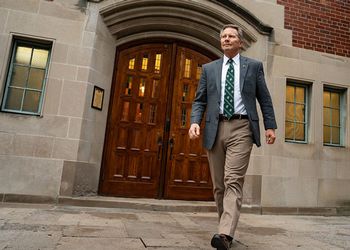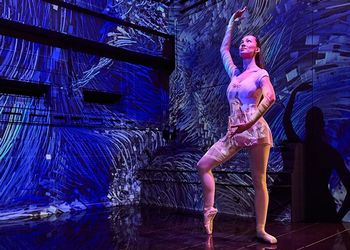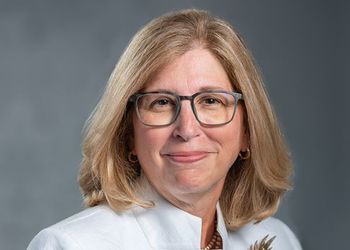Feature: Who Are You Behind the Mask?

A stunning new exhibition, "MASK: Secrets and Revelations,7 ! Will run the remainder of this year at the MSU Museum.
The MSU Museum has always been a popular visitor destination. This year, alumni and friends will be able to enjoy an especially eclectic set of new faces for the exhibit "MASK: Secrets and Revelations," which puts many of its global collections of masks on public display for the first time.
More than a year in the making, this major exhibition features more than 200 masks from around the world, including many that are used in ceremonies and traditions in faraway places and some that are favored by familiar comic book heroes and villains. Even the costume of Sparty, MSU s lovable mascot, is included! Hie exhibit runs through January 2012, giving Spartan alumni and friends plenty of time to visit when they return to campus.
When Gary Morgan became director of the MSU Museum in 2009, he was quickly impressed with the variety and depth of the museums collections, particularly in die strength of its mask holdings. That inspired him from the very get-go to develop an exhibition that would showcase them.
"Masks are both works of art and powerful statements about cultures and human behaviors," Morgan observes. "Ultimately, maskinginall its forms is about transformation.
The mask is perhaps the most evocative manifestation of the human capacity to capture and disguise our own essence in art. When you see this exhibit, you see hundreds of faces, some strange, some very familiar. Yet, for every face there is a story. Sometimes we know the story, and sometimes we do not. So there is also that touch of mystery."
That said, MASK explores issues of spirituality; perceptions of self- identity, power and authority; human rites of passage and the place of people in nature. Included as well are masks used in sport and war, and in the popular media. There are life and death masks, and masks that simply reflect the desire of people to have a good time.
As Morgan notes, "Masks are a universal part of the human experience."
"Whatever its shape and whatever its purpose, the mask changes the face, makes it stronger, exaggerates the features or conceals what the face would otherwise reveal— perhaps our true intent, perhaps our frailty as human beings," he says.
Ideas and artifacts
“ ‘MASK: Secrets and Revelations’ is about identity and perception—how we perceive ourselves, how we want others to perceive us, and how we perceive those around us,” Morgan says.
Essentially, the exhibit is as much about ideas as it is about the artifacts themselves, he says, adding that the intent is not merely to describe a taxonomy of masks and countries. “Certainly, the masks refl ect an extraordinary array of forms, colors and media,” he explains. “Each is a work of art in its own right. More than distinguishing one mask from another, the exhibit asks us to look at ourselves in the masks, and in so doing, to consider our humanity.”
Running across cultures, there are similar themes for the creation and use of masks. Masks can project our inner feelings or hide them. Masks can shield us from danger or can suggest danger to others. Th ey can be part of our assumption of what we would like to be, or of What we fear we may become. We can laugh at the mask, or run screaming from it. And the mask can transform its wearer so as to assume the character of a very diff erent person or of a being from some other world.
“We explore the commonalities of masks, how masks link humanity in shared expressions that are artistic, spiritual and psychological,” says Morgan. “The exhibit is about the mask as artwork, cultural icon and metaphor. From the villages of West Africa, to the carnival of Venice, to the superheroes of comic and screen, MASK traverses a world of creativity and imagination.”
But MASK doesn’t end with spectacular masks and provocative stories on the gallery walls. Another of Morgan’s goals in developing the exhibit was to reach out to tap the energy and expertise from across campus to create an exhibit and an experience.
“MASK is based on a variety of cross-campus collaborations,” says Morgan.
“We want the exhibit and related programs to actively involve faculty and students—as contributors and as participants.”
To that end, he and museum curators worked with MSU faculty and students to develop mask-inspired poetry programs, a specially commissioned theatre performance, and interactive, image-capture kiosks where visitors can literally try on a selection of masks. More is in the works, including films and companion photo exhibits.
“Masks, aft er all, are meant to be worn,” Morgan notes. “We really want this exhibit to come alive and show a sense of movement and vitality that reflects why they were created and how they are used.”
The museum, unmasked
Preparing for a major exhibition also gave Morgan and the MSU Museum a chance to rework some of the museum’s public space. Th e exhibit quickly outgrew the confines of the Main Gallery and visitors will now see parts of the “MASK” exhibit out in the main lobby. Th is transformation now gives the museum more flexible space for changing exhibits, receptions and gatherings.
“The MSU Museum is a dynamic and changing place and visitors see that immediately When they enter the building,” says Morgan. “Our foyer is now another venue to show collections or feature faculty and student work for short-term or experimental installations.”
Primary funding for “MASK: Secrets and Revelations” is from the MSU Office for Inclusion and Intercultural Initiatives, the Asian Studies Center and the African Studies Center. Th e Museum Store also features wearable masks and other exhibit-related items.
Adopt a mask
Alumni and visitors can make their mark and adopt a mask, selecting their favorite mask in the exhibit. For this sponsorship, their names will appear in the gallery beside the mask. Th e “adoption” will help support the exhibit, add-on programs and ongoing care for this significant cultural collection.
For more details, please contact the MSU Museum at pr@museum.msu.edu.
Lora Helou, MA ’90, is communications director for the MSU Museum and its Great Lakes Folk Festival. She has served as co-chairperson of MSU’s Cultural Engagement Communications Committee.



